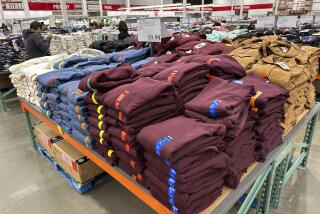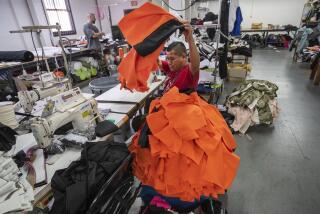Factory Orders in February Retreat 0.8%
WASHINGTON — New orders for manufactured goods declined 0.8% in February, but shipments of goods increased and factories’ order backlogs continued to grow, the Commerce Department said Wednesday. It was the second consecutive monthly drop.
The decline in new orders, which was expected, reflects a buildup of excess inventories that will slow the pace of economic growth, but not severely enough to force mass layoffs or a recession this year, economists said.
The department reported that orders for durable and non-durable goods dropped to a seasonally adjusted $210.86 billion last month after a 0.6% decline in January.
The February setback was the biggest since a 1.4% drop last August and marked the first time that factory orders have fallen for two consecutive months since the summer of 1986.
Economists said the declines showed that businesses cut orders in the early part of the year to trim high levels of unsold goods that had built up in the final three months of 1987.
Optimistic About Growth
While this process will dampen growth, economists said it appeared that the cuts had been moderate and would set the stage for faster growth.
“Basically, this report shows a deceleration, but there is underlying strength in the goods-producing sector of the economy,” said Tom Megan of Evans Economics in Washington.
“You look just a little bit below the surface and there’s still some strength here,” he said.
Strong export demand and investment by businesses seeking to expand their production capacity is expected to keep the manufacturing sector of the economy healthy, he said.
“The economy is expanding at a moderate pace. We are not looking for either a boom or a bust,” said Bruce Steinberg, an economist with Merrill Lynch in New York. “Although we had declines in orders in the past two months, those declines came off a very high level of demand in the fourth quarter.”
Cynthia Latta, senior financial economist at Data Resources in Lexington, Mass., said the order decline is a natural result of a buildup of inventories held by manufacturers, wholesalers and retailers, which is slowing economic growth.
“There’s no reason to lean on the accelerator when you’ve got inventories that you haven’t sold,” Latta said.
Even with the two months of declines, total factory orders were 8.3% higher than a year earlier, reflecting the strong growth in manufacturing demand in 1987. Analysts also noted that the backlog of unfilled orders continued to grow in February, rising by 0.8% to $412.3 billion, indicating that production will have to remain high to fill those orders.
Economists expect manufacturing to be one of the major sources of strength for the economy this year as American companies continue to benefit from a weaker dollar, which has made their products competitive again on world markets.
This export boom is expected to spur U.S. companies to boost their investment spending plans for new plant and equipment, further adding to overall economic growth.
Gauge of Spending Plans
However, the February report said the key category of non-defense capital goods fell 3.9%, although the sector was still 23% higher than a year ago. This category is considered a good gauge of business spending plans on capital equipment.
Jerry Jasinowski, chief economist for the National Assn. of Manufacturers, said the weakness in stock prices and fears about higher inflation rates may be causing some companies to lower their investment spending somewhat.
The February decline in factory orders included a drop of 1.1% in orders for durable goods.
Orders for non-durable goods fell 0.4% in February to $97.9 billion.
More to Read
Inside the business of entertainment
The Wide Shot brings you news, analysis and insights on everything from streaming wars to production — and what it all means for the future.
You may occasionally receive promotional content from the Los Angeles Times.









